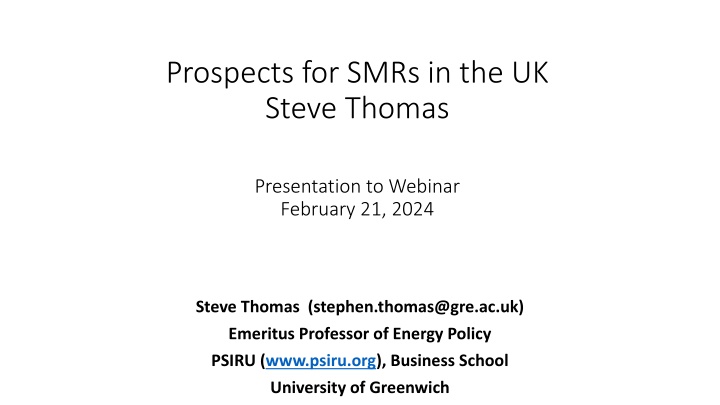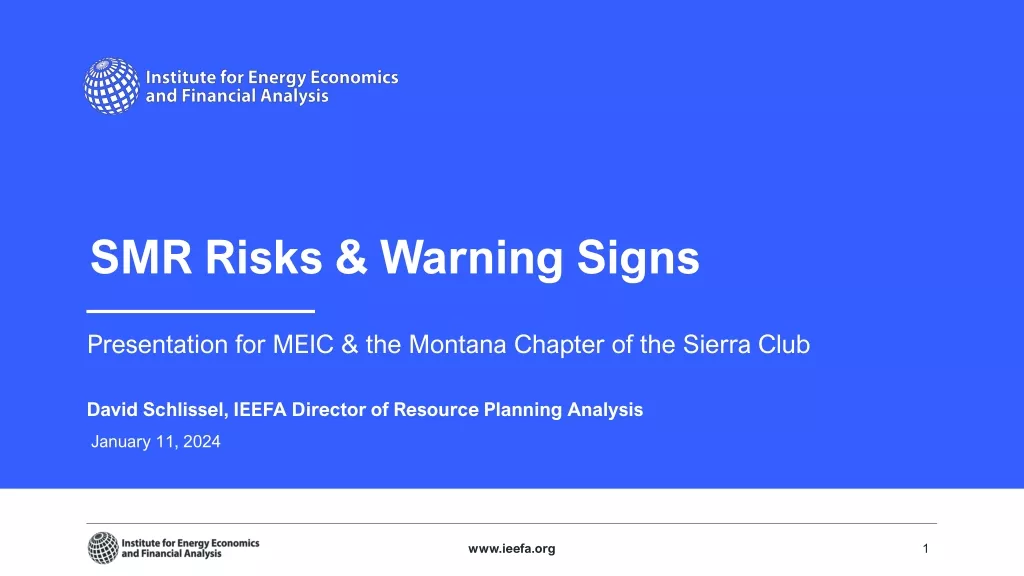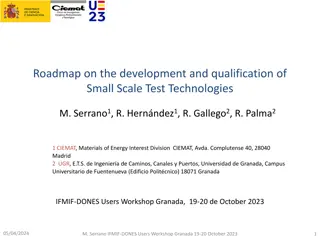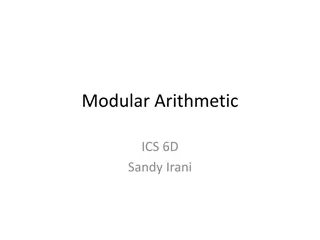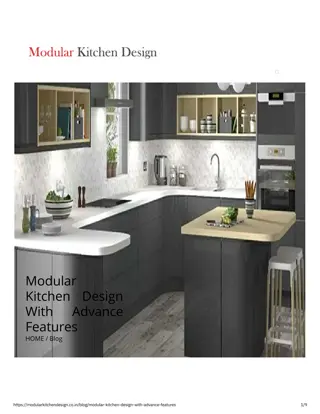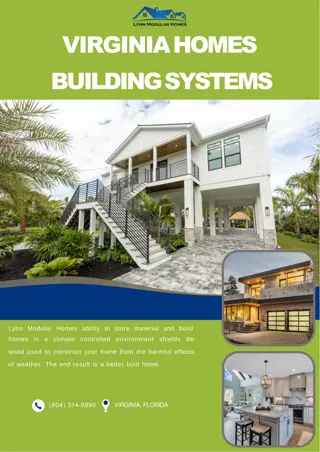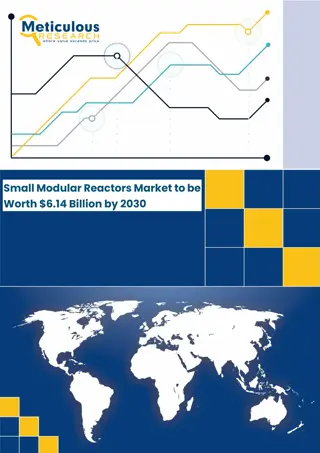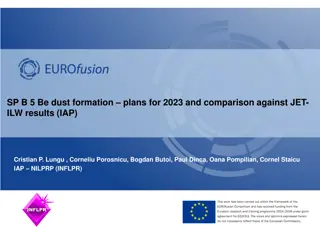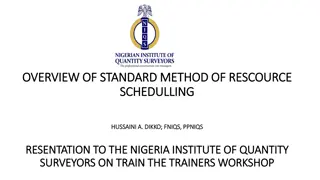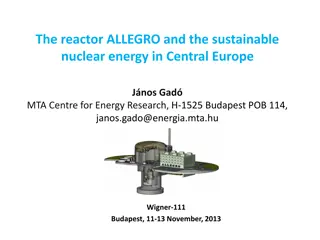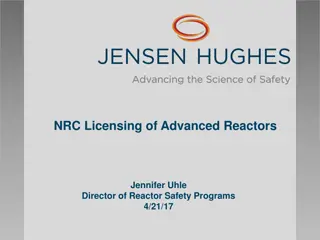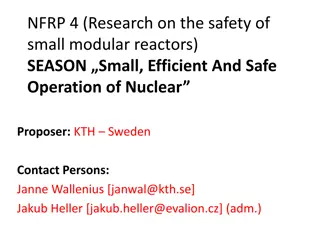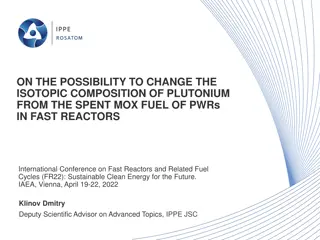Insights on Small Modular Reactors (SMRs) in the UK
Steve Thomas presents an overview of Small Modular Reactors (SMRs), highlighting the challenges and misconceptions surrounding their development and commercial availability. The discussion covers various claims about SMRs, their categorization, and the current status of Advanced Modular Reactors (AMRs) like high-temperature gas-cooled reactors (HTGRs). The presentation also addresses the potential impact of SMRs on achieving Net Zero targets by 2050.
Download Presentation

Please find below an Image/Link to download the presentation.
The content on the website is provided AS IS for your information and personal use only. It may not be sold, licensed, or shared on other websites without obtaining consent from the author.If you encounter any issues during the download, it is possible that the publisher has removed the file from their server.
You are allowed to download the files provided on this website for personal or commercial use, subject to the condition that they are used lawfully. All files are the property of their respective owners.
The content on the website is provided AS IS for your information and personal use only. It may not be sold, licensed, or shared on other websites without obtaining consent from the author.
E N D
Presentation Transcript
Prospects for SMRs in the UK Steve Thomas Presentation to Webinar February 21, 2024 Steve Thomas (stephen.thomas@gre.ac.uk) Emeritus Professor of Energy Policy PSIRU (www.psiru.org), Business School University of Greenwich
Small Modular Reactors (SMRs) For the past decade, there has been increasing levels of propaganda about SMRs. The claims are: They are cheaper & easier to build, less prone to cost & time overruns, easier to finance They are safer, melt-down proof, walk-away safe & produce less waste (kW capacity) than large reactors Being smaller, there will be less opposition to their siting They will create large numbers of new jobs As a result of this, the impression is that large numbers of SMRs are being ordered around the world These claims are unproven or misleading or simply wrong No modern design SMR is operating, 3 prototype SMRs are under construction (China, Russia, India) No current design has completed a full safety review by an experienced & credible regulator. Until this is done, it will not be known if the design is licensable or what the costs would be. So no design of SMR is commercially available to order
What are SMRs? SMR covers such a wide range of sizes & technologies, the term is meaningless IAEA defines SMRs as 30-300MWe (reactors <30MWe are called micro-reactors) They can be divided 2 categories: Smaller versions of the dominant existing reactor types: Pressurised Water Reactors (PWRs like Sizewell B) & Boiling Water Reactors (BWRs); Advanced Modular Reactors: Technologies pursued for more than 50 years, but only built as prototype or demo plants (eg Fast Breeder Reactors), all unsuccessful; & reactor designs long talked about but never built (e.g., Molten Salt Reactors). These are unlikely to be commercially available until after 2040 if ever
AMRs Many types: high temperature gas-cooled reactors (HTGRs), molten salt, lead-cooled fast reactors, sodium cooled fast reactors, UK funded Westinghouse lead-cooled fast reactor in 2020 but now focusing on HTGRs. Hope is HTGRs will be able to operate at 900+C, high enough to allow support the efficient production of hydrogen by thermo-chemical processes Existing HTGRs only operate at 750C. Would require exotic/expensive materials to operate at 900C, assuming safety issues could be overcome X-Energy (80MW HTGR) applied for a GDA in Jan 2023. No response yet from DESNZ BEIS are not currently aware of any viable fully commercial proposals for HTGRs that could be deployed in time to make an impact on Net Zero by 2050. Current evidence suggests that low technology readiness, in the context of potential commercial applications may be one of the reasons for this market failure. Therefore, BEIS will provide support to a demonstration that will address this technology gap and enable HTGRs to contribute to the Net Zero 2050 target.
What are Light Water Reactor options? PWR & BWR SMR designs are at least 80MW & some are larger than 300MW Rolls Royce SMR reactor design, 470MW, larger than any Magnox except Wylfa, about same size as an AGR. Rolls Royce SMR is twice the size of the Trawsfynydd Magnoxes Some designs claim improved safety by use of passive safety systems in an accident, natural processes rather than engineered systems control the reactor integral designs all the major systems are contained in the reactor vessel, not just the reactor & reactors built underground & housed under water Rolls Royce SMR has none of these features Oct 2023 6 PWR & BWR designs selected by Great British Nuclear to bid for UK public money to develop designs: RR, GE-Hitachi, Holtec, Westinghouse, Framatome, NuScale Results in spring 2024, contracts summer. Budget up to 20bn to design & build SMRs
Scale economies/diseconomies The size of reactors has consistently increased since the 1960s. Industry has tried to counter poor economics by seeking scale economies a 1000MW reactor vessel weighs less & costs less than 5 x 200MW reactor vessels Claimed savings from factory manufacture, modularisation etc will have to more than counter lost scale economies Are reactors difficult to build because they are large or because they are complex? Why would small reactors be less complex than large ones unless safety features were significantly cut back? But being cheaper than large reactors is not enough. They have to be cheaper than the cheapest low-carbon options
Is Small or Large beautiful? Experience with AP1000 In 1989, Westinghouse announced AP600 claiming they had looked for scale economies in large reactors but there were none. It was assessed & approved by US safety body in 1998 after 5 years but by then it was clear it was uneconomic, so never marketed Westinghouse scaled it up to 1170MW (AP1000) to improve the economics. It was submitted to US NRC in 2002 but only given final approval in 2011. China scaled design up to 1550MW (CAP1400) to reduce costs. No CAP1400s built yet Now Westinghouse has scaled the AP design down to 300MW Does scaling-up or scaling-down reduce costs? AP series factory-built, modular, passive. But all 8 AP1000s including 4 for China very expensive & way over budget
Production lines/modularisation/factory manufacture The Model T Ford image of identical equipment being made on a rolling production line like car manufacture is misleading. Rolls Royce production lines would produce 2-4 reactors per year Production lines are expensive to set up & inflexible & only cheap if fully loaded. If they are not, they must be closed/mothballed. If the design needs to be changed, there will be expensive retooling costs Rolls Royce wants to make its first reactor on a production line to prove the economics but if this is done, before the first kWh of electricity is generated, at least another 10-12 reactors will be in various stages of manufacture. This is a huge gamble on the design being economically & technically viable. All reactors require a mix of factory work & on-site assembly. The claim for SMRs is simply that the balance is more towards off-site work. The Westinghouse AP1000 is claimed to be modular & factory produced but this did not prevent construction of all 8 reactors ordered going badly wrong
Waste & safety Waste All things equal, a large PWR/BWR will create less waste than the same capacity of small reactors Macfarlane (former Nuclear Regulatory Commission Commissioner) calculates that SMRs will increase the volume & complexity of waste by a factor of 2-30 (e.g., greater neutron leakage) Safety Passive, integral & sub-surface designs are not necessarily safer, they just raise different safety issues Will small reactors be allowed without safety features needed for large reactors?
Jobs Nuclear reactors require large numbers of workers during the construction phase, typically having specific skills unlikely to be found in the local region & these workers may come from abroad. Jobs typically last only a year & this is very disruptive to the local area requiring large amount of short-term accommodation & facilities If SMRs are cheaper & quicker to build than large reactors, they will create less work & over a shorter period If factories with production lines are efficient, they require fewer workers than other manufacture methods. Factories are unlikely to be in the country of order for exports An operating reactor requires few permanent staff. Operators require highly specific skills unlikely to be found among the local population
Conclusions SMR development worldwide reliant on public money Reactor vendors always overstate how close to availability designs are. No SMR design has completed a comprehensive safety review anywhere in the world. It will be 2+ years before 1st review is complete & costs established. Reckless to order an SMR without safety certification Producing new reactor designs is risky, expensive & takes ages. NuScale collapsed after 20 years work & $1bn spent including large amounts of US public money. All vendors looking for large amounts of public money & guarantees of orders to bring their designs to commerciality Traditional vendors don t have funds to develop a new design without strong assurance of orders. Westinghouse & Framatome are emerging from bankruptcy. Scaling down existing designs (AP300 & BWRX-300) is a cheaper way to produce SMR designs but given the large designs are uneconomic, why would smaller ones be better, why would they be less complex? New companies need public funding & partners with skills in nuclear construction to sell reactors
Rolls Royce SMR Announced 2017 as 220-440MW, then 440MW, now 470MW. Old-fashioned design - not integral, not reliant on passive safety, built at surface level. Little interest outside UK Began 4-year UK safety review process in 2022. 1st stage complete, 2ndstage due to complete June 2024, 3rdstage Aug 2026 (certification) Previously seen as a front-runner for UK, but public funding required to develop the design to commercial status, to equip & set up factory production lines & guarantees for orders for 12+ reactors. Tens of billions of required. Can UK government justify this? UK public money runs out when stage 2 of GDA complete. Will more be offered? Using a design developed & funded elsewhere would be cheaper
GE-Hitachi BWRX-300 Announced 2018. Scaled down version of 1520MW ESBWR, passive safety ESBWR design approved by US Nuclear Regulatory Commission in 2014 but never marketed because uneconomic. Why would scaling it down make it cheaper? Preliminary safety reviews underway in Canada & USA Applied to undergo Generic Design Assessment (GDA) in UK in Dec 2022. Application approved by UK government in Jan 2024, given 30m of public funds to undergo first 2 phases of GDA ONR FAQ. Who pays for GDAs. The assessment and all related costs will be paid for by the Requesting Party (RP), the companies who have submitted a design for assessment.
Holtec SMR-160 Announced 2010, as a 160MW PWR with an integral design & passive safety Applied for SMR-160 to undergo GDA in Dec 2023, approved by DESNZ in Dec 2023 & given 34m of public money to undergo first 2 stages of the GDA Between Dec 2023 & Dec 2024, output of reactor doubled (no announcement), now SMR-300 (or SMR160+)
Westinghouse AP300 Announced May 2023. Scaled down version (300MW) of the AP1000 (1170MW). AP1000 (advanced passive) is a modular design relying on passive safety 8 AP1000s sold (USA & China) but all suffered major construction delays (6+ years), were up to 4 times overbudget & 2 of them had to be abandoned after 4 years construction Technology to be used by the Teesside project (Community Nuclear Power) Westinghouse applied for GDA in Feb 2024
NuScale SMR (VOYGR) Dates to early 2000s. NuScale set up 2007, Fluor (large US engineering company) became major shareholder in 2011 Originally 35MW, then 40MW, 50MW, 60MW, now 77MW. Designed to be built in clusters of 12, now also clusters of 4 or 6 reactors. Integral design relying on passive safety. Reactor below ground level, immersed in a water pool 50MW design submitted to US safety authorities in 2016 but when process was complete in 2021, 50MW design already abandoned & scaled up by 50%. Regulatory review restarted from scratch in 2023 Only firm project was the Utah Associated Municipal Power System (UAMPS), announced 2016 as 12x50MW reactors, then 6x77MW reactors. About 50 utilities involved (2-3MW each) but despite large government subsidies only about a third of the capacity committed. Project collapsed in Dec 2023 NuScale seems unlikely to survive
Framatome Nuward Announced 2019. Twin reactors of 170MW each including passive safety, integral design with reactors buried & immersed in water Design still at preliminary stage. Will be built first in France before offered for export. First concrete in France targeted for 2030. Framatome has applied for funding to develop the design. Would British public money going into a French government owned company to develop the design be politically acceptable?
